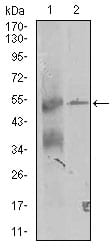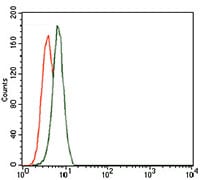TRIP6 Primary Antibody
Item Information
Catalog #
Size
Price
Description
This gene is a member of the zyxin family and encodes a protein with three LIM zinc-binding domains. This protein localizes to focal adhesion sites and along actin stress fibers. Recruitment of this protein to the plasma membrane occurs in a lysophosphatidic acid (LPA)-dependent manner and it regulates LPA-induced cell migration. Alternatively spliced variants which encode different protein isoforms have been described; however, not all variants have been fully characterized.
Product Overview
Entrez GenelD
7205
Aliases
OIP1; OIP-1; ZRP-1; TRIP-6; TRIP6i2
Clone#
6H4
Host / Isotype
Mouse / IgG1
Species Reactivity
Human
Immunogen
Purified recombinant fragment of human TRIP6 (AA: 107-291) expressed in E. Coli.
Formulation
Purified antibody in PBS with 0.05% sodium azide
Storage
Store at 4°C short term. Aliquot and store at -20°C long term. Avoid freeze/thaw cycles.
Product Applications
WB (Western Blot)
1/500 - 1/2000
FCM (Flow Cytometry)
1/200 - 1/400
ELISA
Propose dilution 1/10000
References
1.Biol Cell. 2011 Dec 1;103(12):573-91.
2.Mol Cell Biol. 2010 Dec;30(23):5582-96.
2.Mol Cell Biol. 2010 Dec;30(23):5582-96.
Product Image
Western Blot

Figure 1: Western blot analysis using TRIP6 mAb against human TRIP6 recombinant protein. (Expected MW is 44.4 kDa)
Western Blot

Figure 2: Western blot analysis using TRIP6 mouse mAb against K562 and A431 (2) cell lysate.
Flow cytometric

Figure 3: Flow cytometric analysis of K562 cells using TRIP6 mouse mAb (green) and negative control (red).
Elisa

Black line: Control Antigen (100 ng); Purple line: Antigen(10ng); Blue line: Antigen (50 ng); Red line: Antigen (100 ng);
For Research Use Only. Not for use in diagnostic procedures.

